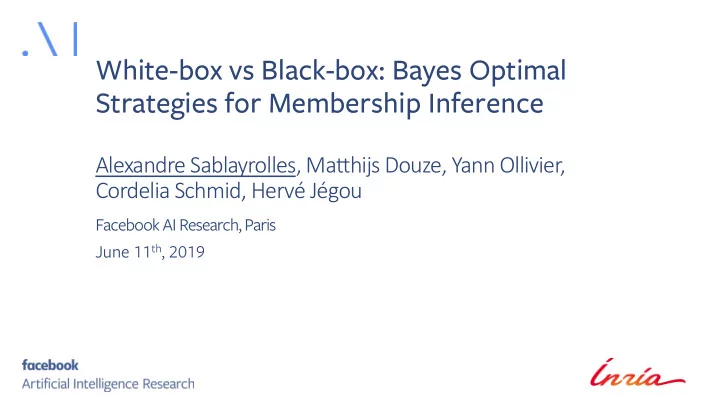

White-box vs Black-box: Bayes Optimal Strategies for Membership Inference Alexandre Sablayrolles, Matthijs Douze, Yann Ollivier, Cordelia Schmid, Hervé Jégou Facebook AI Research, Paris June 11 th , 2019
Context: Membership Inference • Machine learning Machine Learning Model Training set
Context: Membership Inference • Machine learning Machine Learning Model • Membership Inference Training set Membership Inference Model Image in training set ? Candidate images
Membership Inference • Black-box Membership Inference Image in training set Black-box model Candidate ? • White-box images Membership Inference White-box model Image in training set Candidate ? images
Goals • Give a formal framework for membership attacks • What is the best possible attack (asymptotically) ? • Compare white-box vs black-box attacks • Derive new membership inference attacks
Notations Sample z i Membership variable m i Bernoulli( ) λ : training set m i = 1 : test set m i = 0
Notations and assumptions membership • Assumption: posterior distribution ! n − 1 X P ( ✓ | m 1: n , z 1: n ) ∝ exp m i ` ( ✓ , z i ) T i =1 • Temperature T represents stochasticity loss • T=1: Bayes • T->0: Average SGD, MAP inference
Formal results: optimal attack • Membership posterior: M ( θ , z 1 ) := P ( m 1 = 1 | θ , z 1 ) • Result 2 0 1 3 M ( θ , z 1 ) = E T @ s ( z 1 , θ , p T ) } + t λ 4 σ A 5 | {z = 1 ✓ ◆ λ T ( ⌧ p T ( z 1 ) − ` ( ✓ , z 1 )) log sigmoid 1 − λ
Formal results: optimal attack • Membership posterior: M ( θ , z 1 ) := P ( m 1 = 1 | θ , z 1 ) • Result 2 0 1 3 M ( θ , z 1 ) = E T @ s ( z 1 , θ , p T ) } + t λ 4 σ A 5 | {z = 1 ✓ ◆ λ T ( ⌧ p T ( z 1 ) − ` ( ✓ , z 1 )) log sigmoid 1 − λ Only depends on through evaluation of the loss! θ
Approximation strategies • MALT: a global threshold for all samples s MALT ( ✓ , z 1 ) = − ` ( ✓ , z 1 ) + ⌧ • MAST: compute a threshold for each sample s MAST ( ✓ , z 1 ) = − ` ( ✓ , z 1 ) + ⌧ ( z 1 ) • MATT: simulate influence of sample using Taylor approximation 0 ) T r θ ` ( ✓ ∗ s MATT ( ✓ , z 1 ) = � ( ✓ � ✓ ∗ 0 , z 1 )
Experiments Learn model Training set Membership inference Hide in/out label Data Held-out set
Membership inference on CIFAR Threshold-based Taylor based Naïve Bayes Attack accuracy n 0 − 1 MALT MATT 400 52.1 54.4 57.0 1000 51.4 52.6 54.5 2000 50.8 51.7 53.0 4000 51.0 51.4 52.1 6000 50.7 51.0 51.8 => MATT outperforms MALT
Comparison with the state of the art Method Attack accuracy Na¨ ıve Bayes (Yeom et al. [2018]) 69.4 Shadow models (Shokri et al. [2017]) 73.9 Global threshold 77.1 Sample-dependent threshold 77.6 => State-of-the-art performance => Less computationally expensive
Large-scale experiments on Imagenet Model Augmentation 0-1 MALT Resnet101 None 76.3 90.4 Flip, Crop ± 5 69.5 77.4 Flip, Crop 65.4 68.0 VGG16 None 77.4 90.8 Flip, Crop ± 5 71.3 79.5 Flip, Crop 63.8 64.3 => Data augmentation decreases membership attacks accuracy
Conclusion • Black-box attacks as good as white-box attacks • Our approximations for membership attacks are state-of-the-art on two datasets
White-box vs Black-box: Bayes Optimal Strategies for Membership Inference Poster 172 Alexandre Sablayrolles, Matthijs Douze, Yann Ollivier, Cordelia Schmid, Hervé Jégou Facebook AI Research, Paris June 20 th , 2018
Recommend
More recommend